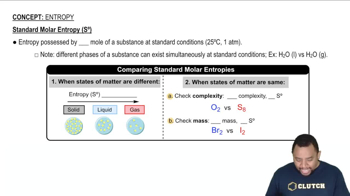Here are the essential concepts you must grasp in order to answer the question correctly.
Standard Entropy
Standard entropy is a measure of the disorder or randomness in a system at a specified temperature, typically 25°C. It is denoted as S° and is expressed in units of J/(mol·K). Higher entropy values indicate greater disorder, which often correlates with the number of microstates available to a substance. Understanding standard entropy is crucial for predicting the spontaneity of processes and the stability of different phases of matter.
Recommended video:
Phase Changes and Entropy
The phase of a substance significantly affects its entropy. Gases generally have higher entropy than liquids, which in turn have higher entropy than solids due to the increased freedom of movement and greater number of microstates in gases. For example, comparing solid and gaseous states of the same element, the gas will have a greater standard entropy due to its higher disorder and molecular motion.
Recommended video:
Comparative Entropy of Solutions
When comparing the standard entropy of a solute in different states, such as gas versus aqueous solution, the solute in solution typically has a lower entropy than its gaseous form. This is because solvation restricts the movement of solute particles, leading to a more ordered arrangement. Thus, understanding how solvation affects entropy is essential for predicting which state will have a greater standard entropy.
Recommended video:
 Verified step by step guidance
Verified step by step guidance

